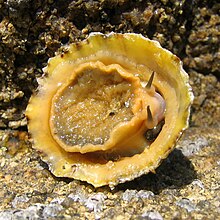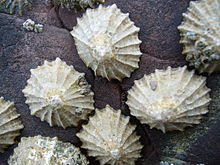Patellogastropoda
| True limpets Temporal range:
| |
|---|---|

| |
| Images of true limpets, shell and live individuals of three species | |
| Scientific classification | |
| Kingdom: | |
| Phylum: | |
| Class: | |
| (unranked): | clade Patellogastropoda Lindberg, 1986
|
| Superfamilies and families | |
|
See text | |
Patellogastropoda, common name true limpets and historically called Docoglossa, is a major phylogenetic group of marine gastropods, seen either as a clade[1] or as a taxonomic order.[2]
Taxonomy
Patellogastropoda was proposed by David R. Lindberg, 1986, as an order later included in the subclass Eogastropoda Ponder & Lindberg, 1996.[3]
2005 taxonomy
Bouchet & Rocroi, 2005 designated Patellogastropoda, true limpets, as a clade, rather than as a taxon, but within included superfamilies and families as listed below. Families that are exclusively fossil are indicated with a dagger †:
- Superfamily Patelloidea
- Family Patellidae
- Superfamily Nacelloidea
- Family Nacellidae
- Superfamily Lottioidea
- Superfamily Neolepetopsoidea
- Family Neolepetopsidae
- † Family Daminilidae
- † Family Lepetopsidae
With the exception of the choice of calling Patellogastropoda a clade rather than an Order as previously by Ponder and Lindberg, 1997 the two are rather similar and differ more in the arrangement of their content than in their overall composition. Bouchet and Rocroi leave out Ponder and Lindberg's suborders and add the Superfamily Neolepetopsoidea.
2007 taxonomy
Nakano & Ozawa (2007)[2] made many changes in the taxonomy of the Patellogastropoda, based on molecular phylogeny research: Acmaeidae is a synonym of Lottiidae; Pectinodontinae is elevated to Pectinodontidae; new family Eoacmaeidae with the new type genus Eoacmaea is established.[2]
A cladogram based on sequences of mitochondrial 12S ribosomal RNA, 16S ribosomal RNA and cytochrome-c oxidase I (COI) genes showing phylogenic relations of Patellogastropoda by Nakano & Ozawa (2007)[2] and superfamilies based on World Register of Marine Species:[4]
| Patellogastropoda | |
Note that family Neolepetopsidae is not in the cladogram above, because its members were not genetically analyzed by Nakano & Ozawa (2007).[2] But two Neolepetosidae species Eulepetopsis vitrea and Paralepetopsis floridensis were previously analyzed by Harasewych & McArthur (2000),[5] who confirmed their placement within Acmaeoidea/Lottioidea based on analysis of partial 18S rDNA.[5] There are also not included in the cladogram families Daminilidae and Lepetopsidae, because they are exclusively fossil families. All of these three families belong to superfamily Lottioidea.[4]
Actual taxonomy based on data by Nakano & Ozawa (2007)[2] with placement of the rest three families (Neolepetopsidae, Daminilidae, Lepetopsidae) into Lottioidea is like this:
- superfamily Eoacmaeoidea
- family Eoacmaeidae
- superfamily Patelloidea
- family Patellidae
- superfamily Lottioidea
- family Nacellidae
- family Lepetidae
- family Pectinodontidae
- family Lottiidae
- family Neolepetopsidae
- † family Daminilidae
- † family Lepetopsidae
In 2007, two years following Bouchet & Rocroi, 2005, Tomoyuki Nakano and Tomowo Ozawa referred to the order Patellogastropoda.[2]
Description

Patellogastropoda have flattened, cone-shaped shells, and the majority of species are commonly found adhering strongly to rocks or other hard substrates, looking like little bumps on the surface. Many limpet shells are often covered in microscopic growths of green marine algae, which can make them even harder to see, as they can closely resemble the rock surface itself.
The majority of limpet species have shells that are less than 3 in (8 cm) in maximum length and many are much smaller than that.
A west Mexican limpet species, the giant limpet, Patella mexicana, is known to grow as large as 8 in (20 cm). This species is now in serious danger of extinction, as it is slow to reach maturity, and has suffered from over collecting, both as a food item, and by shell collectors and dealers.
Distribution
Representatives of the Patellogastropoda, true limpets, live on the rocky coasts of all oceans.
Habitat
Some true limpets live throughout the intertidal zone, from the high zone (upper littoral zone) to the shallow subtidal, but other species live in deep sea in and their habitat include hydrothermal vents, whalebone (baleen), whale-fall[6] and sulphide seeps.[7]
They attach themselves to the substrate using pedal mucus and a muscular "foot". They locomote using wave-like muscular contractions of the foot when conditions are suitable for them to graze. They can also "clamp down" against the rock surface with very considerable force when necessary, and this ability enables them to remain safely attached, despite the dangerous wave action on exposed rocky shores. The ability to clamp down also seals the shell edge against the rock surface, protecting them from desiccation during low tide, despite their being in full sunlight.
When true limpets are fully clamped down, it is impossible to remove them from the rock using brute force alone, and the limpet will allow itself to be destroyed rather than stop clinging to its rock. This survival strategy has led to the limpet being used as a metaphor for obstinacy or stubbornness.
Life habits
Feeding
Most limpets feed by grazing on algae which grows on the rock (or other surfaces) where they live. They scrape up films of algae with a radula, a ribbon-like tongue with rows of teeth. Limpets move by rippling the muscles of their foot in a wave-like motion.
In some parts of the world, certain smaller species of true limpet are specialized to live on seagrasses and graze on the microscopic algae which grow there. Other species live on, and graze directly on, the stipes (stalks) of brown algae (kelp).
Homing behaviour

Some species of limpets return to the same spot on the rock known as a "home scar" just before the tide recedes.[8] In such species, the shape of their shell often grows to precisely match the contours of the rock surrounding the scar. This behaviour presumably allows them to form a better seal to the rock and may help protect from either predation or desiccation.
It is still unclear how limpets find their way back to the same spot each time, but it is thought that they follow pheromones in the mucus left as they move. Other species, notably Lottia gigantea seem to "garden" a patch of algae around their home scar.[9] They are one of the few invertebrates to exhibit territoriality and will aggressively push other organisms out of this patch by ramming with their shell, thereby allowing their patch of algae to grow for their own grazing.
Predators and other risks
Limpets are preyed upon by a variety of organisms including starfish, shore-birds, fish, seals, and humans. Limpets exhibit a variety of defenses, such as fleeing or clamping their shells against the substratum. The defense response can be determined by the type of predator, which can often be detected chemically by the limpet.
Limpets can be long lived, with tagged specimens surviving for more than 10 years. If the limpet lives on bare rock, it grows at a slower rate but can live for up to 20 years.[citation needed]
Limpets found on exposed shores, which have fewer rock pools than sheltered shores and are thus in less frequent contact with water, have a greater risk of desiccation due to the effects of increased sunlight, water evaporation and the increased wind speed. To avoid drying out they will clamp to the rock they inhabit, minimizing water-loss from the rim around their base. As this occurs chemicals are released that promote the vertical growth of the limpet's shell.
Reproduction
Spawning occurs once a year, usually during winter, and is triggered by rough seas which disperse the eggs and sperm. Larvae float around for a couple of weeks before settling onto a hard substrate.[8]
Human use
Larger limpet species are, or were historically, cooked and eaten in many different parts of the world. For example, in Hawaii, limpets (Cellana species) are commonly known as ‘opihi,[10] and are considered a delicacy; the meat sells for £15-25 a pound (454g). In Portugal, limpets are known as lapas and are also considered to be a delicacy. Within Gaelic Scotland and Ireland, a limpet is known as a 'báirnach', and Martin Martin recorded (on Jura) limpets being boiled to use in a substitute for breast milk.
References
- ^ Bouchet, Philippe; Rocroi, Jean-Pierre; Frýda, Jiri; Hausdorf, Bernard; Ponder, Winston; Valdés, Ángel & Warén, Anders (2005). "Classification and nomenclator of gastropod families". Malacologia. 47 (1–2). Hackenheim, Germany: ConchBooks: 1–397. ISBN 3-925919-72-4. ISSN 0076-2997.
- ^ a b c d e f g Nakano T. & Ozawa T. (2007). "Worldwide phylogeography of limpets of the order Patellogastropoda: Molecular, morphological and palaeontological evidence". Journal of Molluscan Studies 73(1) 79-99. doi:10.1093/mollus/eym001.
- ^ Pina -Gastropoda
- ^ a b Gofas, S. (2010). Patellogastropoda. In: Bouchet, P.; Gofas, S.; Rosenberg, G. (2010) World Marine Mollusca database. Accessed through: World Register of Marine Species at http://www.marinespecies.org/aphia.php?p=taxdetails&id=382158 on 2010-04-01
- ^ a b Harasewych M. G. & McArthur A. G. (2000). "A Molecular Phylogeny of the Patellogastropoda (Mollusca: Gastropoda: Eogastropoda)". Marine Biology 137(2): 183-194. http://hdl.handle.net/10088/4613
- ^ McLean J. H. (2008). "Three New Species of the Family Neolepetopsidae (Patellogastropoda) from Hydrothermal Vents and Whale Falls in the Northeastern Pacific". Journal of Shellfish Research 27(1): 15-20. doi:10.2983/0730-8000(2008)27[15:TNSOTF2.0.CO;2]. abstract.
- ^ McLean J. H. (7 November 1990). "Neolepetopsidae, a new docoglossate limpet family from hydrothermal vents and its relevance to patellogastropod evolution". Journal of Zoology, London 222(3): 485-528, plates 1-12. doi:10.1111/j.1469-7998.1990.tb04047.x. Neolepetopsidae is on the page 490.
- ^ a b "Fact files: Common limpet". BBC Science & Nature - Sea life. BBC. Retrieved 2007-09-19.
- ^ A. L. Shanks 2002. "Previous agonistic experience determines both foraging behaviour and territoriality in the limpet Lottia gigantea". Behavioral Ecology 13(4)
- ^ Catharine Lo (photos by Monte Costa). "On the Rocks". Hana Hou! Vol. 9, No. 6. December 2006 / January 2007.
